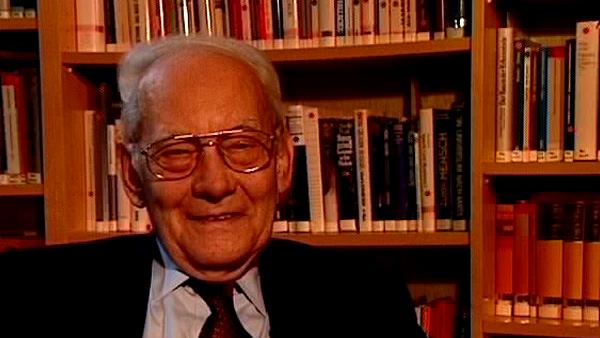NEXT STORY

The kinetic theory of replication, leading to the quasispecies
RELATED STORIES

NEXT STORY

The kinetic theory of replication, leading to the quasispecies
RELATED STORIES



Think of the AIDS virus. If the AIDS virus enters a person... a host, it's just one single virus particle, so before you can measure it in your five... six litres of blood you have in your body, that virus must multiply, multiply, multiply. A biblical verdict, multiply. And you can just detect the virus when it is about a billion particles in your blood. A billion particles is still an exceedingly low concentration. You know...
[Q] 10 to the what...?
... in a gram of water you have about 1024 molecules, that's the Avogadro number, so 109 is a very small number if you take your total blood content of the body. But what does it mean, a billion molecules? There is first only one molecule, and the next moment it duplicates, there are two, and the third moment you have two times two, that means four, then you have eight, you have sixteen, you have thirty-two, sixty-four, and before you get a billion you have to go through thirty such replication rounds, because 230 is just about 109. Which means that all the particles have on average accumulated thirty mistakes, thirty errors, because they have gone through thirty such replication rounds and in each round there is on average one. Of course what you truly have is a Poissonian distribution, which means if you are at your error threshold a third of your molecules has no error, a third has one error and another third has more than one error. That's about what you get at the threshold.
So he had the experimental proof for our quasispecies model. And that convinced us also that we have to do experiments in biology. You cannot just make theory, you have to find out is your theory... do you really find the effect which plays a role in nature. And this turns out to be a general law in nature. Evolution takes place just below the error threshold.
Nobel Prize winning German biophysical chemist, Manfred Eigen (1927-2019), was best known for his work on fast chemical reactions and his development of ways to accurately measure these reactions down to the nearest billionth of a second. He published over 100 papers with topics ranging from hydrogen bridges of nucleic acids to the storage of information in the central nervous system.
Title: Realising that one has to do experiments in biology
Listeners: Ruthild Winkler-Oswatitch
Ruthild Winkler-Oswatitsch is the eldest daughter of the Austrian physicist Klaus Osatitsch, an internationally renowned expert in gas dynamics, and his wife Hedwig Oswatitsch-Klabinus. She was born in the German university town of Göttingen where her father worked at the Kaiser Wilhelm Institute of Aerodynamics under Ludwig Prandtl. After World War II she was educated in Stockholm, Sweden, where her father was then a research scientist and lecturer at the Royal Institute of Technology.
In 1961 Ruthild Winkler-Oswatitsch enrolled in Chemistry at the Technical University of Vienna where she received her PhD in 1969 with a dissertation on "Fast complex reactions of alkali ions with biological membrane carriers". The experimental work for her thesis was carried out at the Max Planck Institute for Physical Chemistry in Göttingen under Manfred Eigen.
From 1971 to the present Ruthild Winkler-Oswatitsch has been working as a research scientist at the Max Planck Institute in Göttingen in the Department of Chemical Kinetics which is headed by Manfred Eigen. Her interest was first focused on an application of relaxation techniques to the study of fast biological reactions. Thereafter, she engaged in theoretical studies on molecular evolution and developed game models for representing the underlying chemical proceses. Together with Manfred Eigen she wrote the widely noted book, "Laws of the Game" (Alfred A. Knopf Inc. 1981 and Princeton University Press, 1993). Her more recent studies were concerned with comparative sequence analysis of nucleic acids in order to find out the age of the genetic code and the time course of the early evolution of life. For the last decade she has been successfully establishing industrial applications in the field of evolutionary biotechnology.
Tags: AIDS virus, Amedeo constant, quasispecies, error threshold, Charles Weissmann, Amedeo Avogadro
Duration: 2 minutes, 35 seconds
Date story recorded: July 1997
Date story went live: 24 January 2008